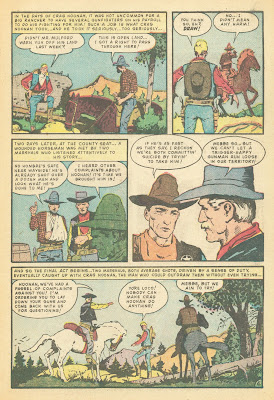Sunday Al Williamson Day.
Today's Al WIlliamson story is exceptional in many ways. First of all, it's seven pages. All stories in Timely's western books were five pages, the later ones even dropped to four. Here editor Stan Lee gives himself the room to use seven pages. This could be because as the editor he could earn himself a few extra bucks by allowing a longer story. Then again, if that's the reason, why didn't he do so more often? Secondly, it doen not have one of his typical one straightlined twist endings. It dies have a twist ending of some sort, but it meanders a bit to get there. He doesn't send up one expectation to end on a twisted version of that. Instead he announces the hero is not someone famous and ends up explaining why. He even realizes this is taking long to do, so he tells the readers twice in which phase of the story they are, using theatre terms ("we are coming to the last act"). One thing that makes this a typical Stan Lee story (apart from the fcat he signed it), is his use of vernacular, phrases like 'yellow-bellied' polecat and 'I reckon'.
As for Al Williams part, the who story is inked in a deliberately thin and shakey line. As good an artist he was, it sometimes seems he was struggling as an inker. But that may have been a deliberate choice. On the bottom of page he tapers out the shadow with a weird scratchy effect (different from the more common way he uses in panel three of page five). He reintroduced that effect in his groundbreaking inking of John Romita Jr. (and others) at Marvel later in his career. It was picked up by some of the early Image inkers and for a short while you saw it everywhere. I also like the light inking of the background on the past panel of the story. He was pushing the ounderies of what was acceptable in the comics pages, creating a distinctively unheroic style, which fits the storyline perfetcly.
Last big question is the arrow pointing upwards next to the job number, where Al Williamson's own arrow would be. It doesn't point to anything in particular, except maybe a group of unrecognisable figures. Is it a sign that Williamson did not ink this one his own (Al Torres certainly could be involved)? Or does any of you have another explenation?









3 comments:
Are you sure this isn't Angelo Torres? With some Williamson input, of course; I know they worked together on many stories. I've always associated the "AT" monogram, or arrow as you call it, with Torres, and this artwork has more of the "sorta like Frazetta" faces and inking that Torres used in his early days than would a typical Williamson job.
I also think that this is Torres, perhaps with a little or no help from Williamson. What book and year did this appear in?
I did not know about the arrow, but stylistically I was reminded of Torres as well. I was just going by the Atlas Tales attribution - which usually are right (certainly more often than the GCD ones are).
Post a Comment